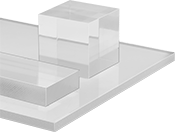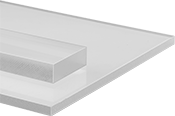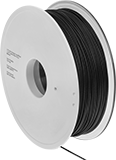About Plastic
More
Clear Scratch- and UV-Resistant Cast Acrylic Sheets, Bars, and Cubes

These cast acrylic sheets, bars, and cubes are often fabricated into tanks, see-through barrier panels, and light fixture lenses. Cast acrylic, which is comparable to Lucite and Plexiglas® Acrylic, is easier to machine than extruded acrylic. The material is scratch resistant and stands up to outdoor use better than polycarbonate. It maintains clarity over time and won't weaken from exposure to UV, though the pigment in colored acrylic will fade over time when exposed to direct sunlight.
- Color: See table
- Temperature Range: -40° to 170° F
- Tensile Strength: 10,000-11,250 psi (Good)
- Impact Strength: 0.3-0.4 ft.-lbs./in. (Poor)
- Hardness: Rockwell M94-M100 (Hard)
- For Use Outdoors: Yes
| Thick. | Thick. Tolerance | Color | Each | |
12" × 12" | ||||
|---|---|---|---|---|
| 1/8" | -0.03" to 0.007" | Bronze | 00000000 | 00000 |
| 3/16" | -0.043" to 0.007" | Bronze | 00000000 | 00000 |
| 1/4" | -0.049" to 0.004" | Bronze | 00000000 | 00000 |
12" × 24" | ||||
| 1/8" | -0.03" to 0.007" | Bronze | 00000000 | 00000 |
| 3/16" | -0.043" to 0.007" | Bronze | 00000000 | 00000 |
| 1/4" | -0.049" to 0.004" | Bronze | 00000000 | 00000 |
12" × 48" | ||||
| 1/8" | -0.03" to 0.007" | Bronze | 00000000 | 00000 |
| 3/16" | -0.043" to 0.007" | Bronze | 00000000 | 00000 |
| 1/4" | -0.049" to 0.004" | Bronze | 00000000 | 00000 |
24" × 24" | ||||
| 1/8" | -0.03" to 0.007" | Bronze | 00000000 | 00000 |
| 3/16" | -0.043" to 0.007" | Bronze | 00000000 | 00000 |
| 1/4" | -0.049" to 0.004" | Bronze | 00000000 | 00000 |
24" × 36" | ||||
| 1/8" | -0.03" to 0.007" | Bronze | 00000000 | 00000 |
| 3/16" | -0.043" to 0.007" | Bronze | 00000000 | 00000 |
| 1/4" | -0.049" to 0.004" | Bronze | 00000000 | 00000 |
36" × 48" | ||||
| 1/8" | -0.03" to 0.007" | Bronze | 00000000 | 000000 |
| 3/16" | -0.043" to 0.007" | Bronze | 00000000 | 000000 |
| 1/4" | -0.049" to 0.004" | Bronze | 00000000 | 000000 |
Clear Impact-Resistant Polycarbonate Sheets and Bars

At only half the weight of glass, these polycarbonate sheets and bars are often used for windows, machine guards, instrument gauge covers, and signs. Polycarbonate is comparable to Lexan, Hyzod, Tuffak, and Makrolon. It has greater impact strength than Plexiglas® Acrylic and can be used in similar applications. Sheets and bars that meet UL 972 are rated as burglar resistant.
Gray and bronze sheets and bars are useful in light-sensitive applications where a see-through material is required.
- Color: See table
- Temperature Range: -40° to 180° F
- Tensile Strength: 8,900-9,500 psi (Good)
- Hardness: Rockwell R118 (Hard)
- For Use Outdoors: See table
- Specifications Met: See table
| Thick. | Thick. Tolerance | Color | For Use Outdoors | Specifications Met | Each | |
12" × 12" | ||||||
|---|---|---|---|---|---|---|
| 1/8" | -0.013" to 0" | Bronze | Yes | UL 94 V-2, UL 972 | 00000000 | 00000 |
| 3/16" | -0.02" to 0" | Bronze | Yes | UL 94 V-2, UL 972 | 00000000 | 00000 |
| 1/4" | -0.026" to 0" | Bronze | Yes | UL 94 V-0, UL 972 | 00000000 | 00000 |
12" × 24" | ||||||
| 1/8" | -0.013" to 0" | Bronze | Yes | UL 94 V-2, UL 972 | 00000000 | 00000 |
| 3/16" | -0.02" to 0" | Bronze | Yes | UL 94 V-2, UL 972 | 00000000 | 00000 |
| 1/4" | -0.026" to 0" | Bronze | Yes | UL 94 V-0, UL 972 | 00000000 | 00000 |
24" × 24" | ||||||
| 1/8" | -0.013" to 0" | Bronze | Yes | UL 94 V-2, UL 972 | 00000000 | 00000 |
| 3/16" | -0.02" to 0" | Bronze | Yes | UL 94 V-2, UL 972 | 00000000 | 00000 |
| 1/4" | -0.026" to 0" | Bronze | Yes | UL 94 V-0, UL 972 | 00000000 | 00000 |
24" × 48" | ||||||
| 1/8" | -0.013" to 0" | Bronze | Yes | UL 94 V-2, UL 972 | 00000000 | 00000 |
| 3/16" | -0.02" to 0" | Bronze | Yes | UL 94 V-2, UL 972 | 00000000 | 00000 |
| 1/4" | -0.026" to 0" | Bronze | Yes | UL 94 V-0, UL 972 | 00000000 | 000000 |
48" × 48" | ||||||
| 1/8" | -0.013" to 0" | Bronze | Yes | UL 94 V-2, UL 972 | 00000000 | 000000 |
| 3/16" | -0.02" to 0" | Bronze | Yes | UL 94 V-2, UL 972 | 00000000 | 000000 |
| 1/4" | -0.026" to 0" | Bronze | Yes | UL 94 V-0, UL 972 | 00000000 | 000000 |
48" × 96" | ||||||
| 3/16" | -0.02" to 0" | Bronze | Yes | UL 94 V-2, UL 972 | 00000000 | 000000 |
| 1/4" | -0.026" to 0" | Bronze | Yes | UL 94 V-0, UL 972 | 00000000 | 000000 |
Easy-to-Print PLA 3D Printer Filaments

The most commonly used 3D printing material, these PLA filaments make detailed parts at a low melting point, so they won’t warp as they cool, rarely clog nozzles, and don’t require a heated printer bed. They’re also unlikely to drip and produce plastic strings for a clean finished part. In general, they’re best for printing prototypes instead of load-bearing parts since they’re not as strong as ABS or as heat resistant as PEEK. Print them on a fused filament fabrication (FFF) 3D printer.
Stainless steel-, iron-, copper-, and brass-filled PLA filaments are heavier and transfer heat better than plastic-only filaments. Brush, sand, or polish printed parts for a metallic finish.
Filaments with an annealing temperature can be heat treated to make parts harder, stronger, and better at resisting heat. To anneal, heat your finished part to the listed temperature and then let it cool slowly.
Tensile strength is the best measure of a filament’s overall strength. Similar to the stress applied on a rope during a game of tug-of-war, it’s the amount of pulling force a material can handle before breaking. A higher rating means a stronger filament. A tensile strength of 5,000 psi and above is considered good; 12,000 psi and above is excellent.
Maximum exposure temperature is the point at which a printed part will begin to deform. Above this temperature, your part will start to lose structural integrity. Filaments that can be annealed are also rated for maximum temperature after annealing, which is the new maximum exposure temperature once that process completes.
Spool | Each | ||||||||||||
|---|---|---|---|---|---|---|---|---|---|---|---|---|---|
| Dia., mm | Printing Temp. | For Printer Bed Temp. | Tensile Strength | Max. Exposure Temp. | Annealing Temp. | Max. Temp. After Annealing | For Min. Nozzle Dia., mm | Dia., mm | Dp., mm | Wt., g | 1-9 | 10-Up | |
Copper-Filled PLA Plastic | |||||||||||||
Opaque Bronze | |||||||||||||
| 1.75 | 185° to 215° C 365° to 419° F | 21° to 60° C 70° to 140° F | Not Rated | 60° C 140° F | 100° to 120° C 212° to 248° F | 155° C 311° F | 0.4 | 200 | 65 | 500 | 0000000 | 000000 | 000000 |





























